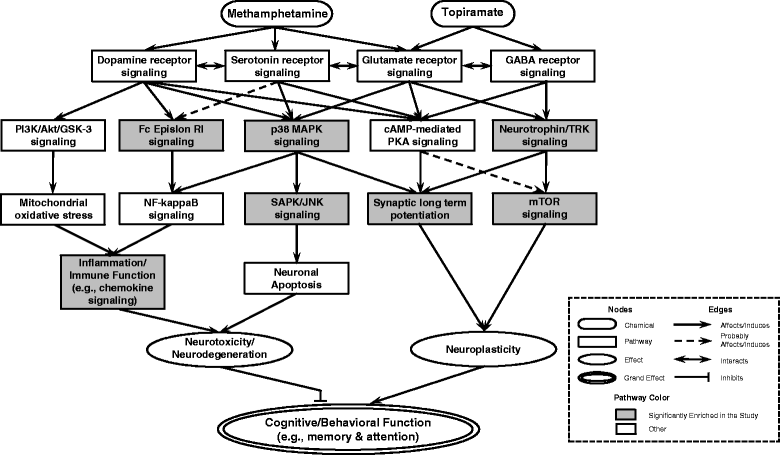Transcriptome profiling and pathway analysis of genes expressed differentially in participants with or without a positive response to topiramate treatment for methamphetamine addiction
- PMID: 25495887
- PMCID: PMC4279796
- DOI: 10.1186/s12920-014-0065-x
Transcriptome profiling and pathway analysis of genes expressed differentially in participants with or without a positive response to topiramate treatment for methamphetamine addiction
Abstract
Background: Developing efficacious medications to treat methamphetamine dependence is a global challenge in public health. Topiramate (TPM) is undergoing evaluation for this indication. The molecular mechanisms underlying its effects are largely unknown. Examining the effects of TPM on genome-wide gene expression in methamphetamine addicts is a clinically and scientifically important component of understanding its therapeutic profile.
Methods: In this double-blind, placebo-controlled clinical trial, 140 individuals who met the DSM-IV criteria for methamphetamine dependence were randomized to receive either TPM or placebo, of whom 99 consented to participate in our genome-wide expression study. The RNA samples were collected from whole blood for 50 TPM- and 49 placebo-treated participants at three time points: baseline and the ends of weeks 8 and 12. Genome-wide expression profiles and pathways of the two groups were compared for the responders and non-responders at Weeks 8 and 12. To minimize individual variations, expression of all examined genes at Weeks 8 and 12 were normalized to the values at baseline prior to identification of differentially expressed genes and pathways.
Results: At the single-gene level, we identified 1054, 502, 204, and 404 genes at nominal P values < 0.01 in the responders vs. non-responders at Weeks 8 and 12 for the TPM and placebo groups, respectively. Among them, expression of 159, 38, 2, and 21 genes was still significantly different after Bonferroni corrections for multiple testing. Many of these genes, such as GRINA, PRKACA, PRKCI, SNAP23, and TRAK2, which are involved in glutamate receptor and GABA receptor signaling, are direct targets for TPM. In contrast, no TPM drug targets were identified in the 38 significant genes for the Week 8 placebo group. Pathway analyses based on nominally significant genes revealed 27 enriched pathways shared by the Weeks 8 and 12 TPM groups. These pathways are involved in relevant physiological functions such as neuronal function/synaptic plasticity, signal transduction, cardiovascular function, and inflammation/immune function.
Conclusion: Topiramate treatment of methamphetamine addicts significantly modulates the expression of genes involved in multiple biological processes underlying addiction behavior and other physiological functions.
Trial registration: ClinicalTrials.gov NCT00345371.
Figures



Similar articles
-
Identification of Novel Signal Transduction, Immune Function, and Oxidative Stress Genes and Pathways by Topiramate for Treatment of Methamphetamine Dependence Based on Secondary Outcomes.Front Psychiatry. 2017 Dec 13;8:271. doi: 10.3389/fpsyt.2017.00271. eCollection 2017. Front Psychiatry. 2017. PMID: 29321746 Free PMC article.
-
Topiramate for the management of methamphetamine dependence: a pilot randomized, double-blind, placebo-controlled trial.Fundam Clin Pharmacol. 2016 Jun;30(3):282-9. doi: 10.1111/fcp.12178. Epub 2016 Mar 4. Fundam Clin Pharmacol. 2016. PMID: 26751259 Clinical Trial.
-
Effects of acute topiramate dosing on methamphetamine-induced subjective mood.Int J Neuropsychopharmacol. 2007 Feb;10(1):85-98. doi: 10.1017/S1461145705006401. Epub 2006 Feb 1. Int J Neuropsychopharmacol. 2007. PMID: 16448579 Clinical Trial.
-
[Topiramate in substance-related and addictive disorders].Presse Med. 2014 Sep;43(9):892-901. doi: 10.1016/j.lpm.2014.02.030. Epub 2014 Jul 11. Presse Med. 2014. PMID: 25027463 Review. French.
-
Trace amine-associated receptor 1: A promising target for the treatment of psychostimulant addiction.Eur J Pharmacol. 2015 Aug 15;761:345-52. doi: 10.1016/j.ejphar.2015.06.019. Epub 2015 Jun 16. Eur J Pharmacol. 2015. PMID: 26092759 Free PMC article. Review.
Cited by
-
The Neuroscience of Drug Reward and Addiction.Physiol Rev. 2019 Oct 1;99(4):2115-2140. doi: 10.1152/physrev.00014.2018. Physiol Rev. 2019. PMID: 31507244 Free PMC article. Review.
-
Identification of Novel Signal Transduction, Immune Function, and Oxidative Stress Genes and Pathways by Topiramate for Treatment of Methamphetamine Dependence Based on Secondary Outcomes.Front Psychiatry. 2017 Dec 13;8:271. doi: 10.3389/fpsyt.2017.00271. eCollection 2017. Front Psychiatry. 2017. PMID: 29321746 Free PMC article.
-
Recent advancements of miRNAs in the treatment of bone diseases and their delivery potential.Curr Res Pharmacol Drug Discov. 2022 Dec 27;4:100150. doi: 10.1016/j.crphar.2022.100150. eCollection 2023. Curr Res Pharmacol Drug Discov. 2022. PMID: 36691422 Free PMC article. Review.
-
aPKC in neuronal differentiation, maturation and function.Neuronal Signal. 2019 Sep;3(3):NS20190019. doi: 10.1042/NS20190019. Epub 2019 Sep 23. Neuronal Signal. 2019. PMID: 32269838 Free PMC article. Review.
-
Therapeutic targeting of neuroinflammation in methamphetamine use disorder.Future Med Chem. 2025 Jan;17(2):237-257. doi: 10.1080/17568919.2024.2447226. Epub 2024 Dec 27. Future Med Chem. 2025. PMID: 39727147 Review.
References
-
- Yang MH, Jung MS, Lee MJ, Yoo KH, Yook YJ, Park EY, Choi SH, Suh YJ, Kim KW, Park JH. Gene expression profiling of the rewarding effect caused by methamphetamine in the mesolimbic dopamine system. Mol Cells. 2008;26(2):121–130. - PubMed
-
- SAMHSA: Results from the 2007 National Survey on Drug Use and Health: National Findings.Office of Applied Studies, NSDUH Series H-34, DHHS Publication No. SMA 08–4343. Rockville, MD: 2008.
Publication types
MeSH terms
Substances
Associated data
Grants and funding
LinkOut - more resources
Full Text Sources
Other Literature Sources
Medical
Molecular Biology Databases
Miscellaneous

